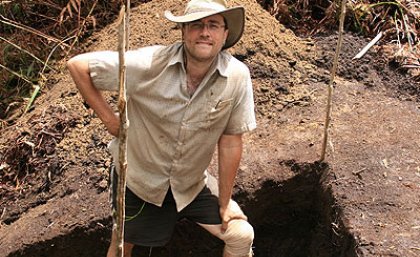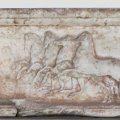
The world’s earliest known high-altitude human settlement, dating back 49,000 years, has been found buried under volcanic ash in the mountains of Papua New Guinea.
The discovery also reveals that Australasia’s first colonisers rapidly moved from coastal regions after their arrival from South East Asia to also inhabit the highlands.
The team of archaeologists, which includes The University of Queensland’s Dr Andrew Fairbairn, discovered campsites at altitudes of 2000m that were occupied 44-49,000 years ago during the last ice-age - the highest altitude sites occupied by Homo sapiens ever recorded. Their findings were published today in one of the world’s most prestigious science journals, Science.
The prehistoric highlanders, who lived in the Ivane Valley of Papua New Guinea’s Owen Stanley Range Mountain near Kokoda, made stone tools, hunted small animals and ate nuts of the local Pandanus tree and yams.
Dr Fairbairn said the team uncovered almost perfectly preserved nutshells at the campsites, which is the first time that such ancient plant material has been found in this region.
“The volcanic ash layers seem to have produced a unique microenvironment that has fought off the rain and cold to preserve nutshells and yam leftovers, which are present in large quantities and gives us exciting and unique evidence of the diet of the first New Guineans,” Dr Fairbairn said.
The campsites were occupied during a relatively warm part of the last ice age – the Pleistocene – when Papua New Guinea was joined to Australia as part of the continent of Sahul. However, the ancient highland people would still have experienced temperatures below 0°C and frequent frosts.
Archaeology team leader, Professor Glenn Summerhayes, from The University of Otago, says the mountain campsites reveal that the early colonisers of Sahul, who crossed the open ocean from South East Asia, were able to push rapidly beyond the coastal areas to inhabit interior mountain regions.
“The sites are among the oldest and best preserved for this key period in Sahul’s past and show that as humans were moving north into the colder climate regions of Europe from their ancestral home of Africa, they were also able to colonise upwards into the cold of the high altitude zone,” Prof Summerhaytes said.
Dr Fairbairn said the discoveries from the Ivane Valley provide an unusually detailed view of a mobile and resourceful community that could adapt rapidly to unfamiliar territory and environments by carefully targeting high-energy plant and animal foods.
“Papua New Guinea’s mountains have long held surprises for the scientific community and here is another one – maybe they were the home of Homo sapiens’ earliest mountaineers,” Dr Fairbairn said.
The paper published in Science was written by Glenn R. Summerhayes (University of Otago), Matthew Leavesley (University of Papua New Guinea), Andrew Fairbairn (UQ), Herman Mandui (National Museum and Art Gallery of Papua New Guinea ), Judith Field (Australian Microscopy & Microanalysis Research Facility), Anne Ford (University of Papua New Guinea), and Richard Fullagar (SCARP Archaeology).
Photos for media
Photos of the Ivane Valley dig site are available for publication by media outlets. Dr Fairbairn is available for interview and has samples of the ancient Pandanus tree nuts.
Media: Dr Andrew Fairbairn (07 3365 2780, a.fairbairn@uq.edu.au) or Kathy Grube at UQ Communications (07 3346 0561, k.grube@uq.edu.au)
.jpg)










